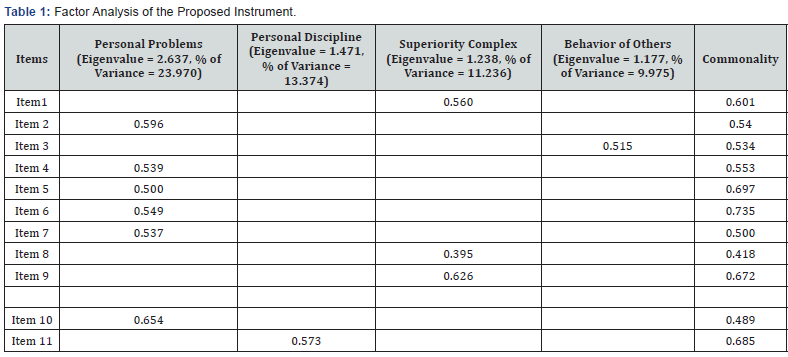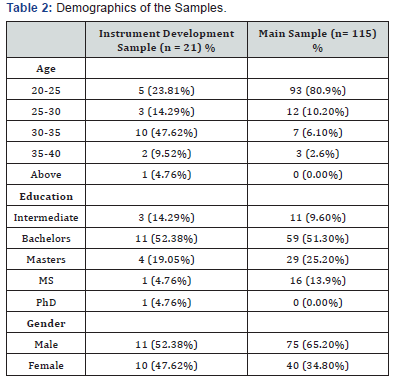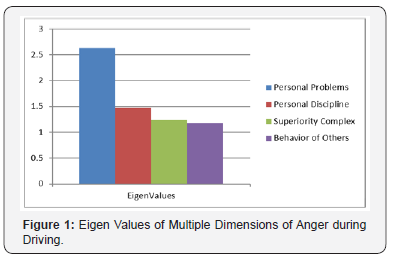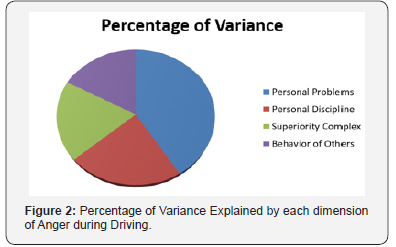Why Do People Get Angry While Driving? The Qualitative Study for Establishing A New Questionnaire
Nadeem Abbas*
KA’s Media Art, Rawalpindi, Pakistan
Submission: July 13, 2018;; Published: July 31, 2018
*Corresponding author:Nadeem Abbas, KA’s Media Art, Rawalpindi, Pakistan, Email: ndhaider2000@gmail.com
How to cite this article: Nadeem Abbas.Why Do People Get Angry While Driving? The Qualitative Study for Establishing A New Questionnaire. Glob J Intellect Dev Disabil. 2018; 5(1): 555652. DOI: 10.19080/GJIDD.2018.05.555652
Abstract
This paper used a method of Confirmatory Factor Analysis in order to identify four dimensions of angriness while driving. 21 interviewees were qualitatively surveyed in order to establish relevant conceptual branches of the construct. 115 respondents from a university of Faisalabad, Pakistan filled prototype questionnaire. Model of convenient sampling was applied to select development and main samples. Four dimensions of Personal Problems (Eigenvalue = 2.637, % of variance = 23.937), Lack of Personal Discipline ( Eigenvalue = 1.471, % of variance = 13.374, Superiority Complex (Eigenvalue = 1.238, % of variance = 11.236) and Behavior of Others (Eigenvalue = 1.177, % of variance = 9.975) were proven to be valid dimensions of the studied concept. Increasing age (B = - 0.222, p < 0.01) and education (B = - 0.158, p < 0.01) drives down potential of experiencing anger while driving.
Introduction
Anger on the road is a mechanical manifestation of hate and disapproval of an individual or a circumstance [1]. However, angriness while driving can undermine one’s performance as a driver and he or she may hurt people physiologically and psychologically. This paper develops a new measure to quantify level of angriness that they experience while driving. Qualitative investigation is carried out with the help of interviews to identify various factors those may predict the degree of anger drivers experience during the process of driving. Reliability and validity of the instrument are reported as well. The study identifies four distinctive dimensions of anger while driving.
Literature Review
People experience higher degree of mental stress because they live in a collective familial system [2]. Each individual fulfills socioeconomic needs of considerable number of individuals and resultant stress interferes with one’s ability to focus on a specific task [3]. People of Pakistan may mindlessly drive a vehicle due to a compromised mental state [4]. Additionally, they transfer blame of poor driving on to others while not understanding their mistakes. Drivers consider others responsible for their poor driving [5]. However, they lack the tendency to take personal responsibility to improve their driving skills [6]. Drivers also do not have sufficient amount of patience that contributes towards increasing frustration on the road. However, one should plan his or her trip with detail in order to reach the intended destination in time. Lack of personal discipline causes people to embark on a journey with considerable delay. Again, they do not take responsibility of managing their time more effectively and they blame other drivers aggressively for getting late [1].
Additionally, majority of Pakistani drivers assume themselves to be above the law and therefore, they behave impolitely towards traffic police. Lack of training is also a byproduct of superiority complex that causes people to drive while not having proper education and licensing [7]. Professional drivers live a financially challenging life in Pakistan and therefore, they tend to behave angrily towards police. Drivers want to violently undermine the personality of policeman in order to get away with their crime on the road [8].
Drivers also respond negatively towards emotionally draining and abusive attitude of bystanders and pedestrians [9]. Drivers may invite one to participate in an unnecessary racing [1]. However, an individual may feel the need to prove his or her supremacy. Rush of adrenaline can cause a person to take irrational decisions on the road. Additionally, one’s companions may interfere with driving by passing judgmental and abusive remarks in order to emotionally disturb an active driver on the road [10].
Methods
Sampling Technique and Procedure
21 interviewees were selected conveniently in order to identify relevant factors those may contribute in making them angry on the road. Conducted interviews were semi-structured and their objective was to classify reasons those make people angry while driving. Additionally, the study developed a prototype questionnaire in order to test validity and reliability of the proposed instrument. Furthermore, the main sample of 115 respondents was selected from an educational institution in Faisalabad by using the method of convenience sampling again to fill the developed instrument. Responses of the main sample were recorded at the bandwidth of 5-point Likert scale (Tables 1 & 2) (Figures 1 & 2).


Instrument development sample had 23.81% respondents with ages between 20 and 25 years. 14.29% of the interviewees had ages in between 25 to 30 years. Additionally, 47.62% sample had reported its age between 30 to 35 years. 9.52% of the selected individuals had ages between 35 to 40 years. Only 4.76% of the sample had age more than 40 years. 14.29% of the same sample reported its education to be intermediate. People with Bachelor’s degree represented 52.38% of the sample. 19.05% of the respondents had a qualification of Masters. Individuals with MS and PhD represented 4.76% of the selected sample each. Males and females had a proportion of 52.38% and 47.62% respectively.


Main sample of the study included 80.9% of respondents whose age was between 20 to 25 years. 10.20% of the sample had ages between 25 to 30 years. 6.10% of respondents reported their age between 30 to 35 years. 2.6% of sample had ages within the range of 35 to 40 years. Individuals with qualification of intermediate represented 9.60% of the sample. Respondents with a bachelor’s degree contributed with 51.30%. 25.20% sample had a degree of masters. 13.9% sample carried a qualification of MS. Males accounted for 65.20% of the sample while females weighted 34.80%.
Reliability of Proposed Questionnaire
The proposed questionnaire to measure anger while driving a vehicle generated a corresponding Cornbach’s Alpha of 0.735. One can consider the established instrument as a reliable means of ascertaining the relevant construct.
Control Variables and Outcome Variable
i. Age and Anger While Driving
People in Pakistan gain more experience due to growing age and therefore, they become calmer and focused with the passage of time. Increased focus and personal calmness may contribute to make elders emotionally and socially stable on the road. Negative experiences of the past also contribute in increasing patience amongst older drivers. Older drivers do not experience significant anger on the road due to enhanced social and emotional stability of the personality [7]. Additionally, past experiences make personality of an older driver calmer and focused.
Ho: Older and younger people experience same level of anger while driving a vehicle
Hi: Older people experience less anger than younger individuals while driving a vehicle
ii. Education and Anger While Driving
Education is also a source of increasing behavioral soberness in the society of Pakistan. Educated people often treat others as equal citizens on the road due to higher level of educational and spiritual enlightenment. Educated persons also constantly feel the need to correct and improve their behavior while driving due to powerful inclination to experience continuous technical growth as a driver [3]. Educated people also treat traffic police with respect due to same factor of perceived social responsibility.
Hii: Educated and ignorant people experience same degree of anger while driving
Hiii: Educated people experience less anger than ignorant ones while driving
iii. Gender and Anger While Driving
Pakistan is a masculine society and therefore, males feel superior to females. Social superiority complex of men translates into higher level of anger on the road [10]. Males exhibit significantly higher degree of anger than females while driving due to feeling of social superiority.
Hiv: Males and females experience comparative level of anger while driving
Hv: Males experience more anger than females while driving
Results (Table 3)
Age negatively affects presence of anger during the process of driving a vehicle. This study accepts Ho (B= - 0.222, p < 0.01). Older drivers experience less anger while driving than younger ones. Educational development also lessens presence of rage in drivers (B = - 0.158, p < 0.01). This paper also considers Hiii as an empirically truthful statement. Finally, males and females exhibit comparative level of anger during their time as a driver (Sum of Squares = 0.013, p > 0.05). Hiv is accepted resultantly.

Discussion
Personal issues interfere with driving skills of a person in Pakistan. People of Pakistan manage extraordinary familial responsibilities [10]. Significant number of people is living dependently on earnings of sole earners of large families. Earners and jobholders have a momentous task of managing and meeting expectations of dependent individuals. Females and males show equal degree of anger while driving because professionally active people face similar level of familial tensions [1]. Youth does not want to pursue a specific profession with commitment and therefore, earners of corresponding families experience more stress in order to generate extra money to financially support inactive human resources. Increasing tension and stress contribute in making people angry while driving. Lack of personal discipline and poor time management also causes people to experience unnecessary delays on the road and therefore, they feel anger due to getting late from their relevant offices [7]..
Superiority complex also increases anger in drivers because they consider themselves as members of an elite class. Drivers do not tolerate obstructing behavior of others on the road. Drivers behave negatively towards other users of the road due to sense of social superiority. Unhealthily proud drivers also identify officials of traffic police as low level creatures [1]. Drivers with superiority complex do not obey the law and they also do not respect the officials. Proud drivers often engage in physical and verbal contest with officials of traffic police and they do not admit their mistakes as well. Finally, technical mistakes and errors of other users make drivers extremely unhappy. Technical supremacy can also prove as a source of developing pride in drivers. They do not recognize others’ potential of making an error on the road and drivers behave harshly as a result of minute mistakes of other users of the road [3]. Increasing age and education reduces the potential of angriness in drivers because they become spiritually and operationally calmer due to experiential and academic learning [4].
Limitations of the Study
This investigation is conducted in one locality of Pakistan and it does not study a larger sample and therefore, readers may not be able to derive generalized implications from this work
Future Directions for Research
Future projects on the topic of anger while driving may study larger samples in order to generalize findings of the present work. Additionally, only four dimensions of the construct are discovered by this paper. However, researchers can expand the prevalent theory in order to identify hidden dimensions of the concept.
References
- Stephens AN, Ohtsuka K (2014) Cognitive biases in aggressive drivers: Does illusion of control drive us off the road? Personality and Individual Differences 68(1): 124–129.
- Li Y, Ashkanasy NM, Mehmood K (2017) The experience of anger and sadness in response to hurtful behavior: Effects of gender-pairing and national culture. Asia Pacific Journal of Management 34(2): 423–441.
- Taubman O, Kaplan S, Lotan T, Prato GC (2016) The combined contribution of personality, family traits, and reckless driving intentions to young men’s risky driving: What role does anger play? Transportation Research Part F: Traffic Psychology and Behaviour 42(2): 299-306.
- Deffenbacher JL, Stephens AN, Sullman MJ (2016) Driving anger as a psychological construct: Twenty years of research using the Driving Anger Scale. Transportation Research Part F: Traffic Psychology and Behaviour 42(2): 236-247.
- Berdoulat E, Vavassori D, Sastre MT (2013) Driving anger, emotional and instrumental aggressiveness, and impulsiveness in the prediction of aggressive and transgressive driving. Accident Analysis & Prevention 50(1): 758-767.
- Scott Parker B, Salmon GP (2015) The driver, the road, the rules … and the rest? A systems-based approach to young driver road safety. Accid Anal Prev 74(1): 297-305.
- Deffenbacher JL, Lynch RS, Oetting ER, Swaim RC (2002) The Driving Anger Expression Inventory: a measure of how people express their anger on the road. Behaviour Research and Therapy Vol 40(6): 717– 737.
- Sullman MJ, Stephens MJ, Kuzu D (2013) The expression of anger amongst Turkish taxi drivers. Accid Anal Prev. 56(2): 42-50.
- Klauer SG, Guo F, Simons Morton BG, Ouimet MC, Lee SE, et al. (2014) Distracted Driving and Risk of Road Crashes among Novice and Experienced Drivers. The New England Journal of Medicine 370(1): 54-59.
- Lansdown TC, Stephens AN (2013) Couples, contentious conversations, mobile telephone use and driving. Accid Anal Prev. 50(1): 416-422.






























